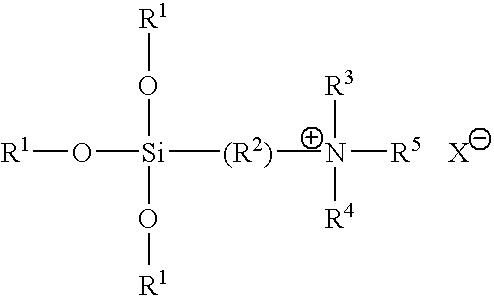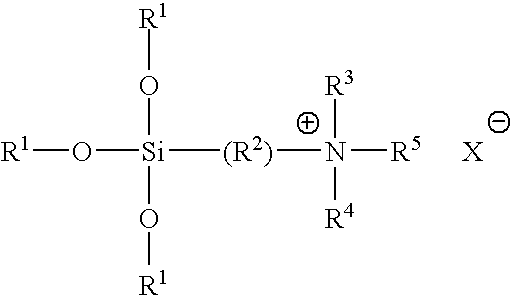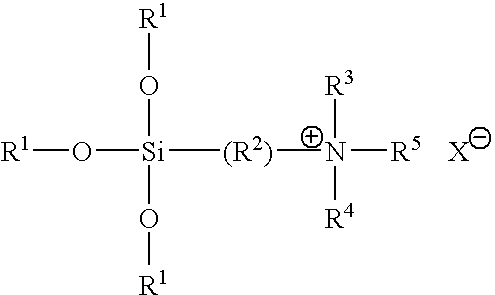Surfactant-free cleansing and multifunctional liquid coating composition containing nonreactive abrasive solid particles and an organosilane quaternary compound and methods of using
a liquid coating composition and non-reactive abrasive technology, applied in the direction of detergent compositions, liquid soaps, detergent compounding agents, etc., can solve the problems of surface destroying cycle, harsh cleaning aids, increased soil buildup, etc., to prevent attachment and growth, improve surface cleaning and bonding of organosilane quat, and reduce formation and adhesion. and buildup.
- Summary
- Abstract
- Description
- Claims
- Application Information
AI Technical Summary
Benefits of technology
Problems solved by technology
Method used
Image
Examples
examples 1-17
[0086] The compositions of this invention were formulated from liquids (water, water thickened with 2% hydroxypropylcellulose and ethanol thickened with 2% hydroxypropylcellulose), various abrasives and various siliconized quaternaries. The examples were hand mixed to homogeneous slurries, gels and creams as discussed in the following Table II with reference to the C-12Q, C-18Q, C-18=Q, C=18Q and C-22Q quats labeled in paragraph [0027] above.
[0087] The compositions were tested on various soiled surfaces by application of a small amount of the composition to the soiled surface and massaging the composition into the soil with a paper towel and a circular overlapping motion. The scrubbed surface was then rinsed with water to remove the excess composition and the loosened soil. The cleaned surface was dried and examined for any remaining soil and was tested for water repellency.
[0088] In all cases, no remaining soil could be observed on the cleansed surface and the surfaces were found...
examples 18-25
[0089] Additional compositions of this invention were formulated from liquids as defined in Examples 18-25. Various abrasives were formulated with 3-(trimethoxysilyl)propyldimethyloctadecyl ammonium chloride (C-18Q) and hydrogen peroxide. The examples were hand mixed to homogeneous gels, creams and liquids as defined in the following Table III.
[0090] The compositions were tested on the various soiled surfaces by application of a small amount of the composition to the soiled surface and massaging the composition into the soil with a paper towel and a overlapping circular motion. The scrubbed surface was then rinsed with water to remove the excess composition and the loosened soil. The cleaned surface was dried and examined for remaining soil and water repellency.
[0091] In Examples 18-25, the compositions removed the water spots and majic marker stains and the cleaned surfaces were found to be excellent (E) with respect to water repellency or good to excellent (G-E).
[0092] In Examp...
example 26
[0099] To determine the synergistic activity of the hydrogen peroxide and the organosilane quaternary compound in the presence of an abrasive, the formulation of Example 22 was repeated without hydrogen peroxide. The Comparative Bonding Test for the two formulations resulted in good repellency without hydrogen peroxide and excellent repellency with hydrogen peroxide thereby demonstrating synergism.
PUM
| Property | Measurement | Unit |
|---|---|---|
| Fraction | aaaaa | aaaaa |
| Percent by mass | aaaaa | aaaaa |
| Percent by mass | aaaaa | aaaaa |
Abstract
Description
Claims
Application Information
 Login to View More
Login to View More - R&D
- Intellectual Property
- Life Sciences
- Materials
- Tech Scout
- Unparalleled Data Quality
- Higher Quality Content
- 60% Fewer Hallucinations
Browse by: Latest US Patents, China's latest patents, Technical Efficacy Thesaurus, Application Domain, Technology Topic, Popular Technical Reports.
© 2025 PatSnap. All rights reserved.Legal|Privacy policy|Modern Slavery Act Transparency Statement|Sitemap|About US| Contact US: help@patsnap.com



